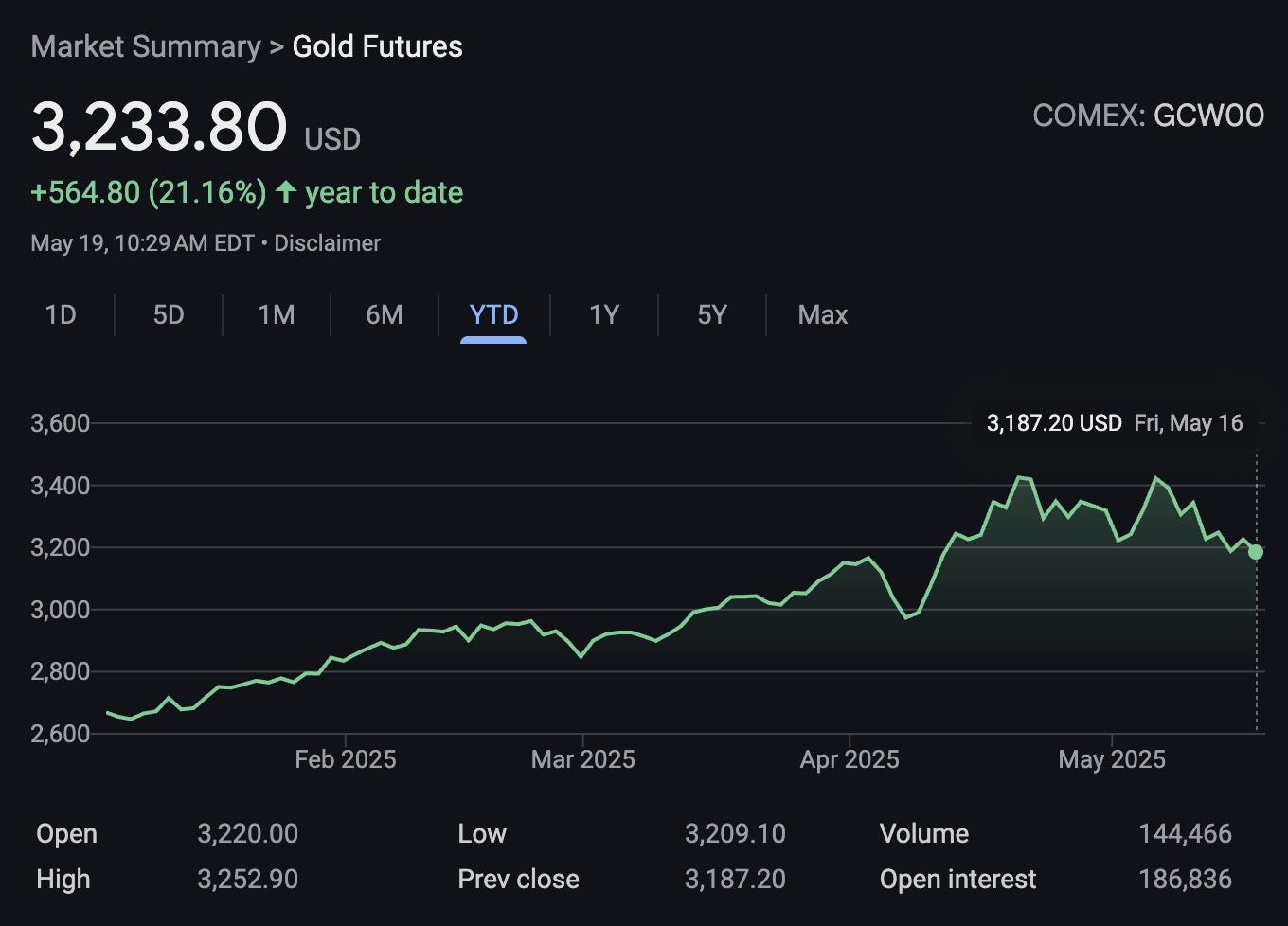Gold is up 21% so far this year, while the S&P 500 is basically flat.
Gold is widely treated as a safe store of value in times of disruption. Investors today are turning to gold as a hedge against inflation, global uncertainty, and looming tariff wars. Volumes have been written about the pros and cons of investing in gold to protect one’s portfolio against these relatively familiar risks.
However, it does seem like participants in the contemporary gold rush might not be pricing in a less familiar risk–the impact of the oncoming intelligence explosion on gold supply.
At the time that I’m writing this, the prediction market Polymarket shows a 12% chance that OpenAI announces it has achieved AGI by the end of this year. Kalshi puts the odds at 56% before 2030. Metaculus predicts AGI will be achieved by January 2034. Many of the top AI CEOs expect AGI in the next 1-5 years, with a few predicting closer to 10 years.
It doesn’t matter who you believe, or even if you think they’re all off by multiple decades. Radical change due to AGI is likely not that far away. If you’re saving for retirement, AGI is a genuine macro risk.
AGI will enable cascading technological revolutions in everything from robotics to energy generation to space travel to manufacturing. This will, in turn, revolutionize the economy and all of our supply chains, but it will have an unequal impact from asset to asset, and will likely impact different asset classes on very different timelines. In some cases, this will yield an abundance of many assets we consider scarce today. These supply shocks will rapidly change which assets we think of as “safe” or as reliable stores of value.
For long-term investors looking for a reliable store of value, the question is: what assets maintain their value through the intelligence explosion? What remains scarce in the age of abundance?
Perhaps no asset is safe. Gold is just one of many examples, but it seems particularly emblematic of an asset whose scarcity we take for granted.
The total amount of gold ever mined is surprisingly limited. Humans have been mining gold for thousands of years, but only ~216,000 metric tons of gold have been mined to date. This is just enough to fill up just over 4 Olympic-sized swimming pools.
One bottleneck is finding rich concentrations of gold that can be mined efficiently, but startups like Earth AI are already successfully leveraging AI to accelerate the discovery of new gold systems.
Mining itself has mostly been limited by conditions amenable to human survival, making it difficult to mine gold under the ocean or deep in the Earth’s crust. Continental crust is typically 25 miles thick, but our deepest gold mine (Mponeng) is only 2.5 miles deep - barely 10% of the way down. Autonomous underground robots could mine deeper in the crust than humans can go. Deep-sea mining is still nascent; even so, the International Seabed Authority has already signed more than 30 contracts for exploration of deep-sea mineral deposits.
Even on the upper crust, human labor and energy makeup around half of the cost for gold mining. So newly abundant energy and advanced robotics might slash both, turning many low-grade, currently unviable deposits into profitable mines.
Finally, space-mining holds the potential to make Earth-based gold mining irrelevant. VC-backed startups like AstroForge are already working on launching missions to mine asteroids. There are single metal-rich asteroids we know of–like 16 Psyche–that on their own contain many orders of magnitude more gold than the entire market of gold on Earth.
I’m sure there are excellent counterarguments to any one of these technologies disrupting the gold supply, but from a risk perspective, the overarching point holds - gold as a reliable store of wealth cannot be taken for granted. An intelligence explosion will render commonplace many of the things we consider valuable.
Technology-enabled supply explosions are nothing new. Napoleon III was reported to honor guests with aluminum silverware, while lesser guests ate with utensils of gold. In the 1800s, the price of a pound of aluminum crashed from hundreds of dollars to 25 cents. Centuries before, the value of salt was similar to gold. In the 1700s, porcelain was worth more than gold. Both are household items today.
Could this all take a lot longer than I’m suggesting, even with AGI? Maybe, but I don’t think so. The gap between our technological capabilities today and our technological capabilities tomorrow is directly a function of the amount of intelligence at our disposal. Even merely human-level intelligence with the speed, memory, and coordination of machines will solve many problems a lot faster than we can possibly imagine.
So what remains scarce in a world of abundance? What bottlenecks remain, even with godlike technology at our disposal? Here are a few that come to mind:
Land: There’s only so much land, at least on Earth. Progress might reduce some demands for land - with an abundance of luxury green skyscrapers, for example, or efficient vertical farming - but unless we’re all living in VR full-time, my guess is that a substantial demand for limited desirable land remains.
Digital Assets: When the world of atoms becomes easy to manipulate, cryptographically-enforced scarcity remains. There will only ever be 21 million Bitcoin, no matter how advanced AI becomes.
Fine Art: Fine art isn't valued for its functionality nor solely for its aesthetic qualities, but also for its provenance, cultural context, and originality. Even if AI can generate billions of technically flawless paintings daily, the authenticity and creative legacy behind original works remains unique. The Mona Lisa's worth isn't only in its pigments, but also in its historical significance.
Social Status: A friend suggested this one, and I found it insightful, even if it's not viable for your 401k. Human attention is a zero-sum game. In a world of super-abundance, being someone people pay attention to might be more valuable than ever (note to self: blog more).
Perhaps the ultimate scarcity in a post-AGI world will be a unique perspective. With an intelligence that can learn and mimic every known pattern and idea in humanity's vast dataset, maybe the most valuable asset is our weirdest thoughts and most idiosyncratic experiences—something novel to feed a superintelligence ravenous for unseen data.
What am I missing? If you’ve got ideas, I’d love to hear from you.
.png)




